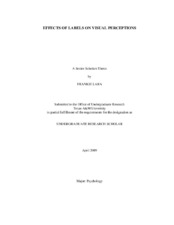| dc.description.abstract | Labels simplify our world by reducing complex ideas into simple phrases. Research
suggests that labels even alter our visual perception to the point that we think images
carrying common labels look similar to each other even when they are not. The present
study shows that this is valid for perception of human faces and reveals that labels
carrying specific categories of meaning are particularly more powerful in changing our
perception. In two experiments, participants were presented with a triad of morphed
human faces paired with arbitrary labels. The meanings of these labels were manipulated
to represent the belief, the food, the disease, or the “face’s” last name. The results
indicated that labels carrying conceptual information such as beliefs, food, and diseases
were particularly strong in modifying participants’ judgment of similarity of individual
faces, whereas labels characterized with last names of faces were least powerful. These
results suggest that how we visually analyze an object is not confined to sensory
modalities such as sight, hearing, or smell, but also to semantic information we relate to
iv
it. In other words, we shape what we see in terms of what we know about what we are
seeing. | en |


